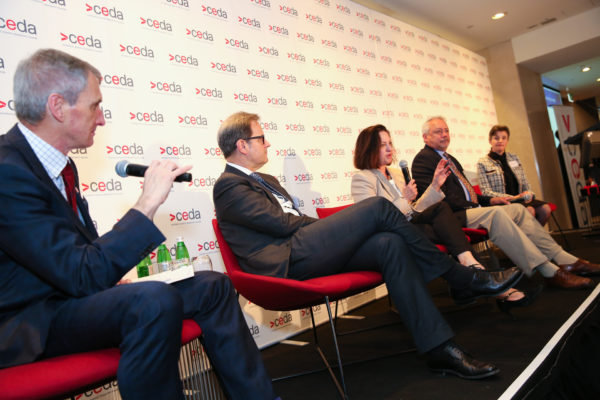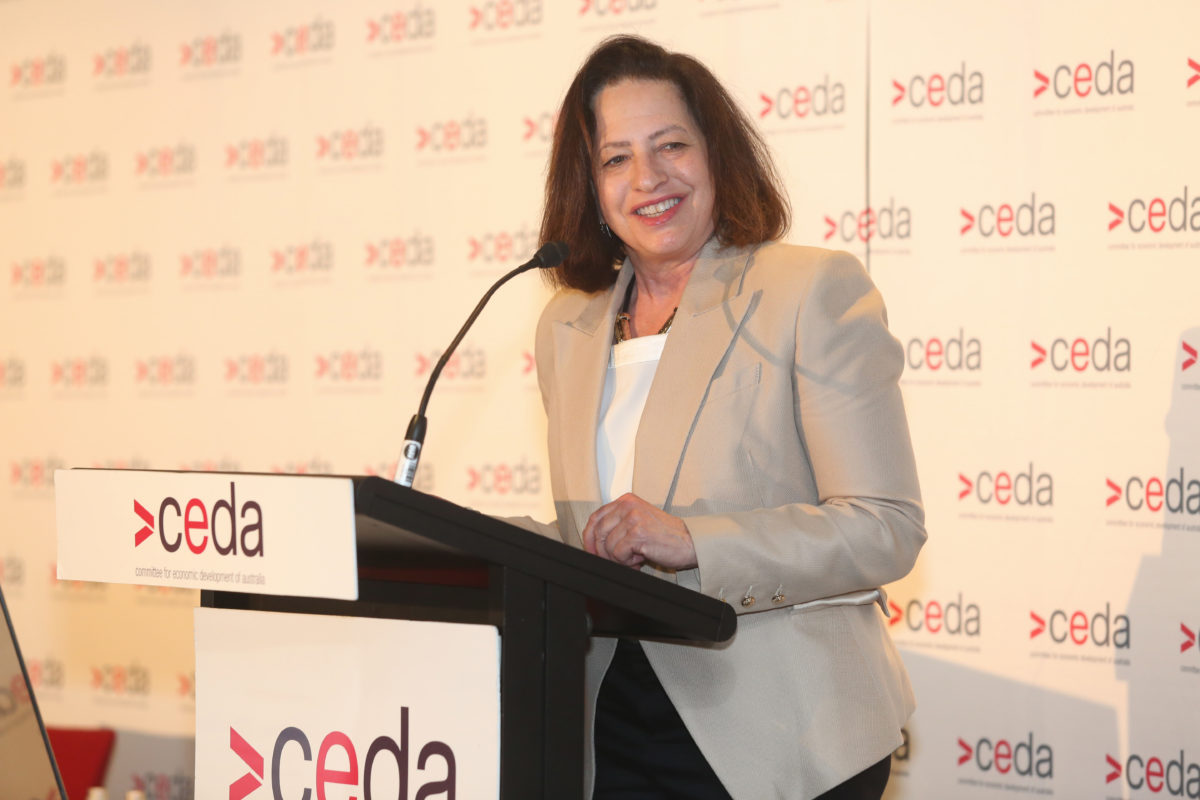Radical transparency has been a hallmark of Audrey Zibelman’s leadership of the Australian Energy Market Operator (AEMO), and like energy in the future electricity system, data will flow bi-directionally between customers and energy providers, policymakers and investors, she told attendees at a lunch held by the Committee for Economic Development of Australia (CEDA) on Friday.
Planning for a future energy system featuring dispersed intermittent solar and wind generation in place of centralised coal generation has endless interdependent permutations, but since March 2017, AEMO CEO and Managing Director, Zibelman has applied experience, vision and consultative transparency to the task.
Now in an alliance with Australia’s Commonwealth Scientific and Industrial Research Organisation (CSIRO) and with funding from the Australian Renewable Energy Agency (ARENA), AEMO is seeking to further demystify the future flow of electrons with digital twins — data-informed replicas that mirror the National Electricity Market (NEM) and Western Australia’s Wholesale Electricity Market (WEM) in real time, and can be used to model proposed changes to every aspect of the grids.
“The hardest thing about power and gas is they tend to be invisible. What we as humans see is the lights coming on, but we need policymakers and investors to see how the grid is going to function so that they can invest with a great deal of confidence.”
At the recent Australian Clean Energy Summit 2019, Dr Tim Finnigan, Director of Energy at CSIRO, said, “We need these real-time science-based tools … No-one in the world has transformed an energy system of the scale we have, at the pace we’re trying to do it.”
The digital twins of the NEM and the Wholesale Energy Market (WEM) of Western Australia, will allow all parties “to see what AEMO is seeing, and to understand why we say we need more transmission here, and if we don’t put transmission here … Here are the consequences,” said Zibelman.
Coordination of new power generation — at the moment primarily solar PV and wind — with improved transmission and distribution, and markets that reflect the real value of cheap energy and essential grid services is at the core of AEMO’s mission to serve the long-term interests of energy consumers in Australia.
Currently, AEMO models Australia’s energy market development in its biannually updated Integrated System Plan under five different “scenarios”, which include the Central scenario based on current market signals; and Fast and Slow Change scenarios.
“I think we all know the tools AEMO has available to it are not quite up to scratch,” Finnigan said at ACES 2019.
The inescapable logic of data modelling
Being able to rapidly model outcomes of design changes to the grid in a digital replica that integrates gas distribution and financial settlement markets will serve as powerful demonstration to doubters and dithering parties and a keen encouragement for accelerating changes that can be shown to have beneficial outcomes.
The constant, fast-changing relationships and ratios between penetration of rooftop solar and storage, and development of large-scale solar, wind and storage, and retirement of thermal capacity can’t currently be taken into account quickly enough to ensure confidence that supply throughout the grid will stay in balance with demand.
“This is billions of dollars of infrastructure that needs to come in,” said Zibelman in the CEDA context of economic opportunity, “The more we can de-risk the system, the more we can attract capital; and that’s going to be beneficial for consumers because it’s cheaper.”
Industry concern is also growing that investment in technologies such as storage which will help ensure the reliability of a system powered increasingly by intermittent renewables, is not being incentivised by current pricing mechanisms.

Image: CEDA
Valuing grid firming in Australia’s energy mix
Simon de Bell, Head of Corporate Development at ABB Australia, chaired the panel of industry experts that followed Zibelman’s address to the CEDA event, and asked how the market could capture and value the cost to industry of providing dispatchable energy.
“If you’re a generator, if you want to make a very substantial investment in a gas peaker or pumped storage or a large battery … the business models are a bit challenging,” said Ian Learmonth, CEO of the Clean Energy Finance Corporation.
Investors consider various revenue sources, such as arbitrage in the case of pumped hydro storage, and the Frequency Control Ancillary Services (FCAS) market, and weigh up the outlook for Federal Government to potentially devalue such long-term investments with competitive projects.
Zibelman, who previously worked in United States energy companies and utilities, proffered one US example of day-ahead markets and scheduling, as giving value to firming services. In the day-ahead markets, she explained, generators bid to supply portions of the next day’s demand. If a renewable generator, say, is unable to supply its bid due to poor resource on that day, it must then purchase the equivalent energy to fulfil their commitment, and can choose to buy from a facility providing energy stored in a large-scale battery, from a coal-fired plant, a gas generator and so on.
The AEMO CEO also identified the growing potential of purchasing demand response — offering discount or credit, say, to residential and significant commercial consumers who agree to reduce their load at times of peak demand. These are all price signals that value investment and reliability.
Data rights and applications
The panel alluded to the recent requirements for the Consumer Data Right, to give consumers greater access to and control over their data as it isused in banking, energy and telecommunications services. Such transparency will further enable a two-way highway of data and energy, as consumers discover more about their energy consumption habits and how they can manage them not only to decrease their electricity bills and change providers, but to participate in the energy market.
“We intend to do that very quickly,” said Zibelman, of enabling Consumer Data Rights and providing both meter and pricing data to consumers within the shortest possible time frame.
“We want consumers to have all the information they need about about how they’re using energy,” said Zibelman, who added, “We have a proposal in to the Australian Energy Market Commission to allow for customers in the energy sector to switch providers in two days.”
Data, harnessed by advanced computing, distributed in meaningful form, and visualised in a digital twin of energy market operations will improve agility and quality of decision making for consumers and for policy makers, says Zibelman.
“The amount of data that we have to use to manage the power system going forward is quadruple times infinitesimally more than we had historically. We’re not just dealing with 30 large generators,” she points out. Today, she says, “we have four million resources” and “millions of bits of information”.
The digital twin of Australia’s electricity systems east and west, will let everyone “get as much information as they need to make the best investment decisions, and policymakers can understand the consequences of their decisions”.
This content is protected by copyright and may not be reused. If you want to cooperate with us and would like to reuse some of our content, please contact: editors@pv-magazine.com.









By submitting this form you agree to pv magazine using your data for the purposes of publishing your comment.
Your personal data will only be disclosed or otherwise transmitted to third parties for the purposes of spam filtering or if this is necessary for technical maintenance of the website. Any other transfer to third parties will not take place unless this is justified on the basis of applicable data protection regulations or if pv magazine is legally obliged to do so.
You may revoke this consent at any time with effect for the future, in which case your personal data will be deleted immediately. Otherwise, your data will be deleted if pv magazine has processed your request or the purpose of data storage is fulfilled.
Further information on data privacy can be found in our Data Protection Policy.